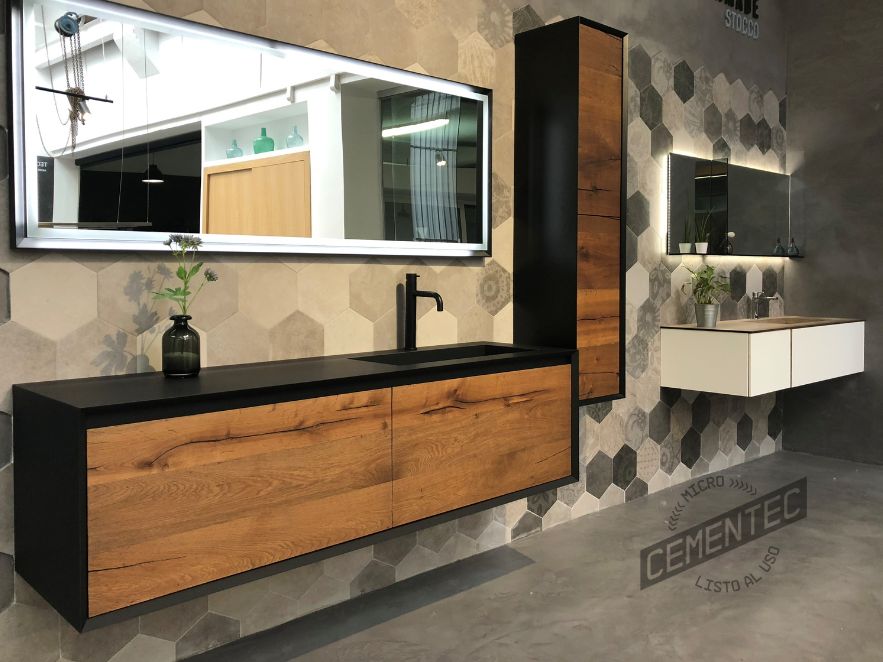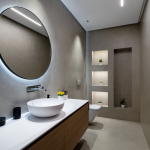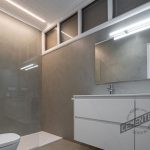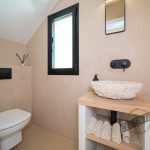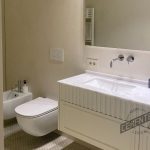Learning and knowing how to decorate bathrooms has become one of the most important aspects in interior design in recent years. Both specialists and designers agree that one of the most widespread premises or popular trends is the combination of microcement and wood in any room of the house. However, if there is a unique combination using these materials that we should focus on and analyze in detail, it is the combination of microcement and wood in bathrooms.
This combination achieves a modern and warm look in the environment. In addition, its complete versatility and customization allow for a unique and limitless design for the space. That’s why it becomes the ideal choice for those who love cozy, elegant, and harmonious spaces that convey an unparalleled sense of home.
Cementec presents you the most popular decorative coating option for bathroom remodeling. Discover microcement and wood bathrooms like you’ve never seen them before and learn about their uses, combinations, advantages, disadvantages, as well as tips to keep your bathrooms shining like new.
Keep reading and learn everything you need to know about this combination of materials for your bathroom decoration.
Why combine microcement with wood in bathrooms?
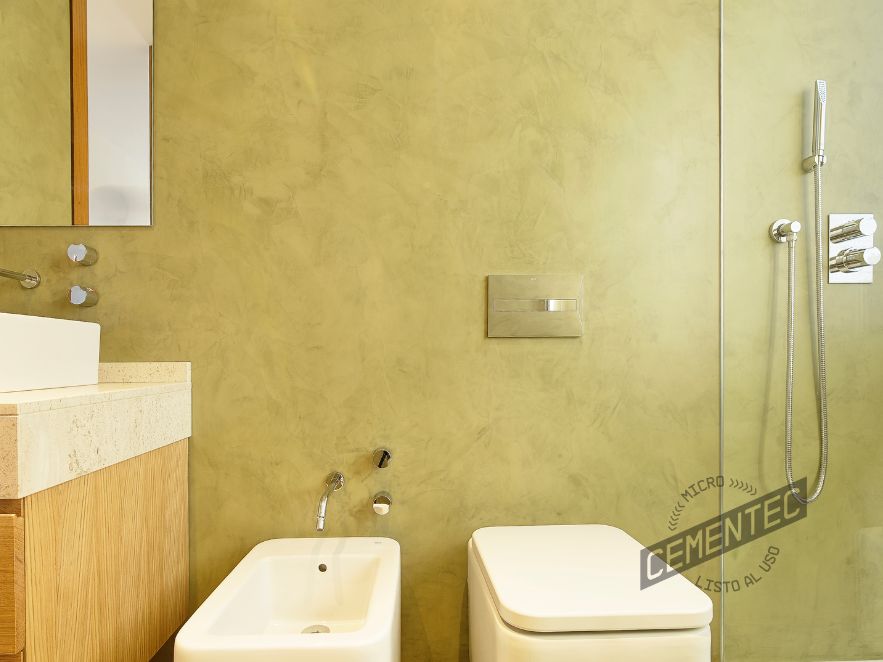
The combination of microcement and wood in bathrooms has numerous positive factors. First and foremost, ready-to-use microcement stands out for its versatility, as it can be used on both walls and floors, allowing for a wide range of possibilities when creating designs and finishes.
At the same time, wood is a material inherently associated with warmth and elegance. It can be used in different tones, allowing for playing with contrasts and achieving a unique atmosphere. Wood can be found in various elements of the home, such as mirror frames, shelves, and other furniture pieces.
Therefore, the combination of microcement and wood creates a modern and rustic ambiance simultaneously, which is ideal for those who seek eclectic decoration. But if you want to know why microcement and natural wood are the perfect duo, don’t miss this article we have for you.
Next, let’s analyze the different options available when combining these elements in the bathroom.
Microcement and wood on walls
An interesting option is to use ready-to-use microcement on the walls of the microcement shower area or on the rest of the bathroom walls, combined with a wooden wall on one side.
Applying microcement on walls provides resistance, waterproofing, and easy maintenance. At the same time, wood adds warmth and elegance to the environment and can also be used for mirror frames, shelves, and other decorative elements.
Microcement and wood on floors
Similarly, another effective option is to apply microcement on the shower floor or coat built-in bathtubs with microcement and combine it with a wooden floor in the rest of the bathroom.
The resulting modern atmosphere is very interesting. Considering the qualities of microcement mentioned earlier, its resistance to direct contact with water is excellent. Wood, on the other hand, can also be used for baseboards, stairs and other decorative elements.
Microcement and wood in furniture or decorative elements
Furthermore, as we have mentioned in the previous two points, the combination of wood and microcement is not limited to walls and floors alone. For example, wooden furniture can be paired with microcement countertops, or vice versa. Microcement shelves or drawers with wooden details, or the other way around, are also possible.
Overall, this combination creates a rustic-modern character that fits perfectly with eclectic decoration.
How to effectively combine microcement and wood in bathrooms
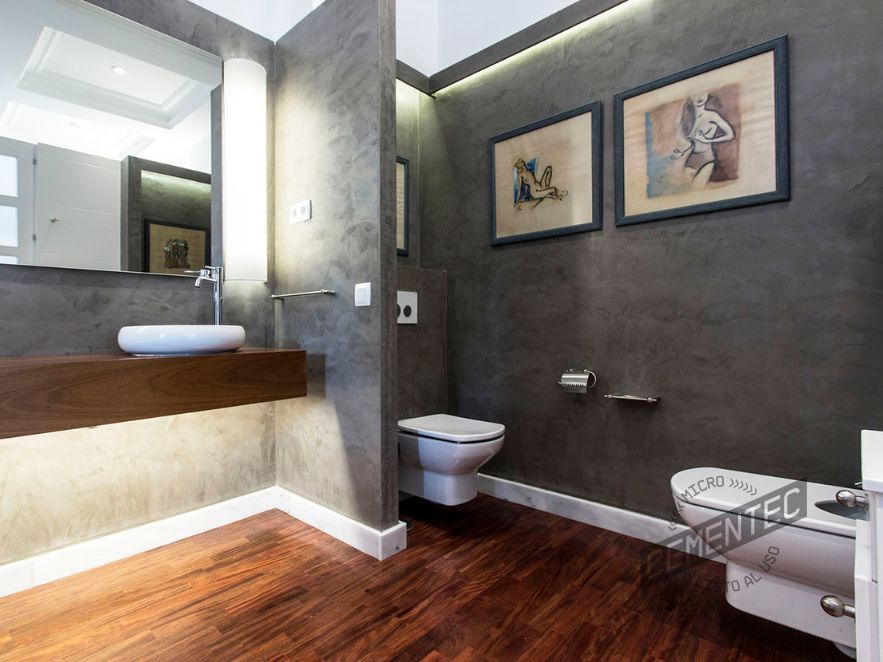
To achieve a harmonious and balanced combination of microcement and wood in bathroom design, it is important to consider the following tips:
- Choose an appropriate color palette: It is generally recommended to combine the gray of microcement with warmer wood tones such as walnut, oak, or cherry.
- Play with textures: For example, you can use furniture with rough finishes and polished microcement countertops, or microcement walls with weathered wooden shelves.
- Use proper lighting: To highlight the combination of microcement and wood, warm lighting with spotlights in key areas is recommended.
- Seek harmony: This involves selecting furniture and decorative elements that align with the chosen combination while avoiding elements that may create discord or imbalance.
Learn the advantages and disadvantages of microcement and wood bathrooms
Similarly, considering the combination results, ready-to-use microcement alongside natural wood used in bathrooms presents a set of advantages and disadvantages that are important to consider before choosing it for your renovation.
Discover them with Cementec.
Advantages of microcement and wood bathrooms
- Provides a modern and warm atmosphere simultaneously, making it an ideal choice for those seeking an eclectic style of decoration. It allows for combining different design elements and styles to create a unique and personalized atmosphere.
- Highly versatile, allowing for a wide variety of designs and finishes to meet the needs and tastes of different individuals. It can adapt to any interior design style or preference.
- Resistant, waterproof, and easy to maintain, making it a durable and high-quality choice. These materials can withstand a significant amount of wear and resist exposure to various elements, making them popular for a variety of design projects.
Disadvantages of microcement and wood bathrooms
- Can be more expensive than other bathroom decoration options due to the complexity of installation and the quality of materials used.
- Requires proper and regular maintenance to preserve its appearance and quality, as these materials can deteriorate over time, resulting in additional costs for repairs or replacements.
Above all, speaking of the latter point, Cementec has a couple of tips for you.
Tips for maintaining microcement and wood bathrooms
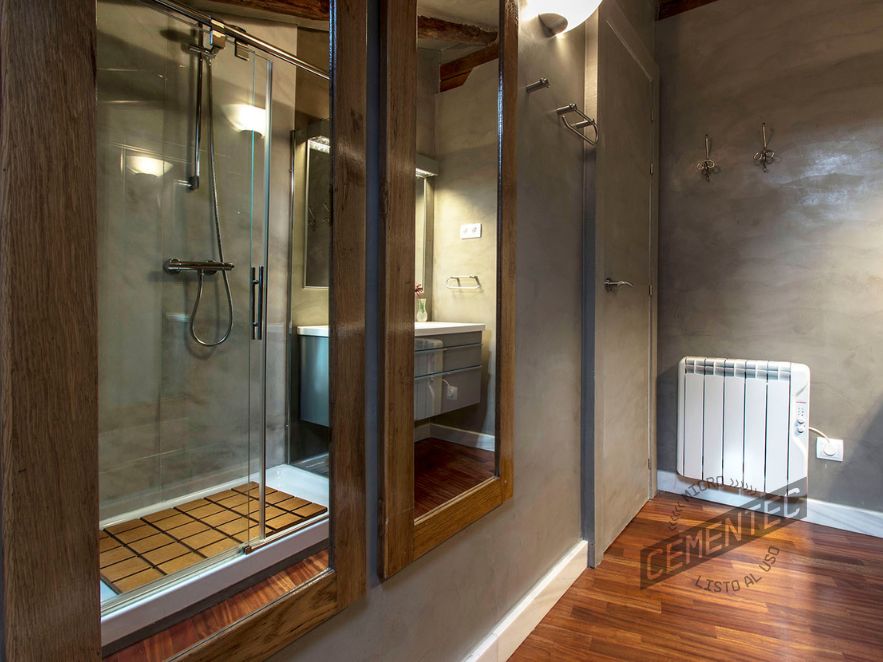
- Regular cleaning: To maintain the original appearance of microcement and wood, it is recommended to use specific cleaning products for microcement and wood, avoiding the use of aggressive or abrasive products.
- Protection against moisture: Microcement and wood are sensitive to moisture, so it is important to adequately protect them. The use of sealants and surface protectors is recommended to prevent moisture absorption and extend the lifespan of the materials.
- Wood maintenance: It is advisable to regularly apply special oils or waxes for wood to preserve its quality, avoiding the use of products containing alcohol or solvents.
- Timely repairs: If any cracks, fissures, wear, or problems are detected in the microcement or wood, it is essential to carry out timely repairs to prevent further damage. It is recommended to consult a professional specializing in the repair and maintenance of these materials.
Conclusions
The combination of microcement and wood in bathroom design is a modern and elegant option that allows for creating warm and cozy environments. However, it is important to consider its advantages and disadvantages, as well as follow practical design and maintenance tips to preserve its appearance and quality over time.
If you wish to use this combination in your bathroom, it is recommended to seek high-quality and trustworthy products, as well as seek the guidance of a professional specialized in microcement application. This way, you can achieve a unique and personalized bathroom that reflects your style and personality.
Did you find this article about microcement and wood bathrooms interesting? Share your opinions on our social media and let us know your recommendations or results after applying these concepts.
